Week #3. A little biology goes a long way.
- On: June 05, 2019
 1
1
Biological knowledge that is. Let’s talk about two situations where knowing just a little more biology makes a big difference.
Perplexing Ginger
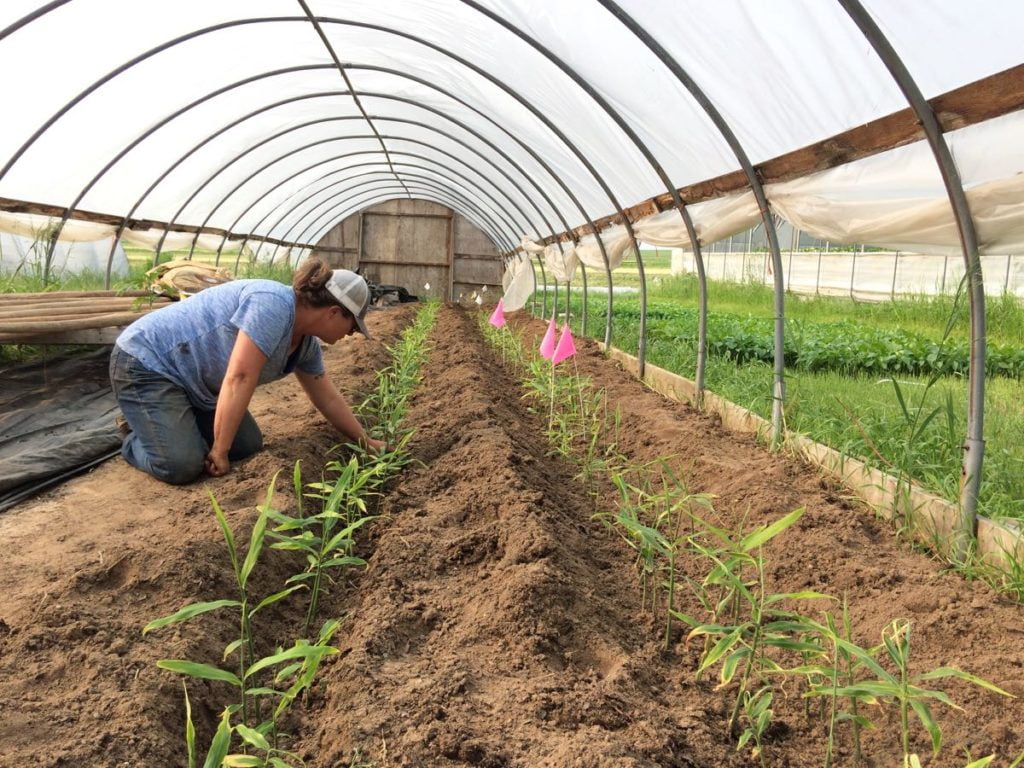
Kristen plants ginger on Friday.

Jory holds a beautiful cluster of baby ginger harvested during the outstanding 2015 season.
I nearly quit growing ginger. We’ve raised ginger for the CSA for 8 years. Yields have always been discouragingly low, except 2015 when growth was tremendous. That year, the ginger ‘seed’ we bought (cut pieces of gingerroot) arrived more sprouted than usual. We get the seed in March and keep it in a warm growth chamber for one to three months until it sprouts. I’ve tried to replicate early sprouting in subsequent years, without success. I love this crop and didn’t want to give up.
Instead of quitting, I contacted the nursery manager at our ginger seed supplier. I explained our low yields. Dan wrote back, “Hi Beth. The main reason the ginger sprouts faster has to do with the moisture content of the rhizome. It is facilitated by leaving it to dehydrate for a few weeks in a dry room. Dryer ginger sprouts faster.”
Who knew?? Everything I’ve read said nothing about this. I’ve always kept the seed carefully wrapped in towels so it wouldn’t dry out. We followed Dan’s advice and shortened the sprouting time by a full month. That gives the ginger an entire extra month to grow. That’s a big deal. I’m glad I made the small effort to learn more. This should be a good ginger year. We’ll find out this fall. Beth
Coddle Your Watermelons Seedlings
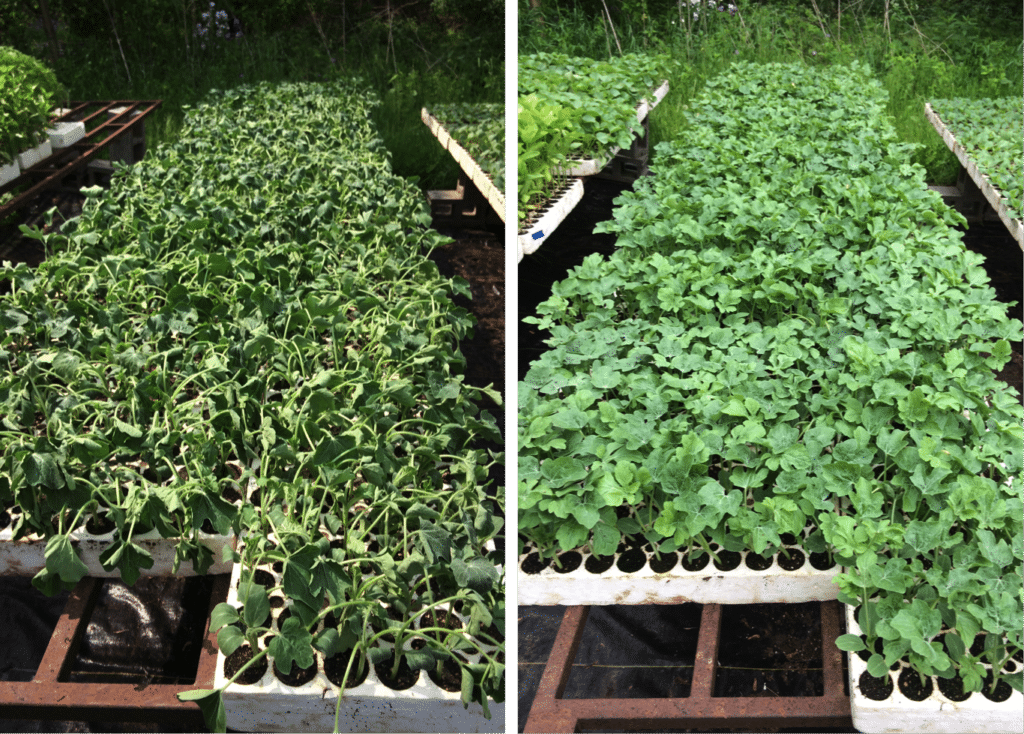
Left, watermelon seedlings, wilted after a cold night. Right, same seedlings, a few hours later.
Watermelon seedlings faint in cold weather. If their roots are cold and wet, the plants wilt dramatically. The roots stop taking up water but the tops continue to transpire. It can be fatal; the roots will die if left cold and wet. The seedlings look like they need watering but that’s the last thing you want to do. The solution is to warm the plants, and do not water until the root balls have warmed. We’ve learned over the years to be very cautious watering melon seedlings during chilly weather.
Farm News; Spinning Our Wheels
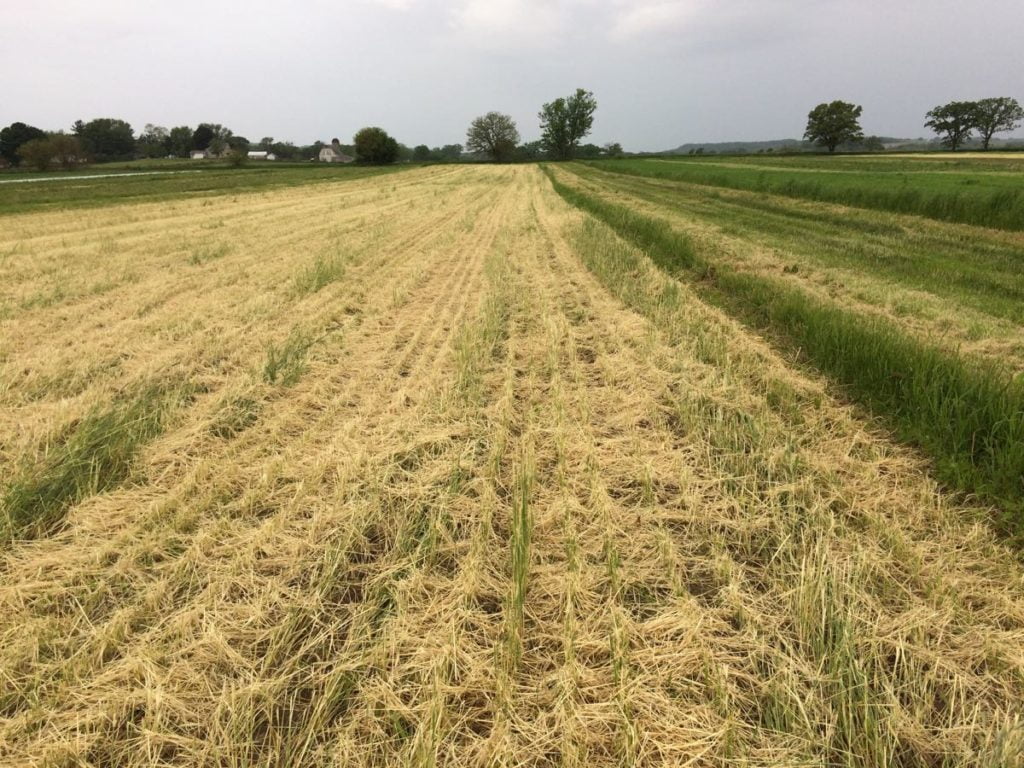
Chopped rye cover crop awaits tillage.
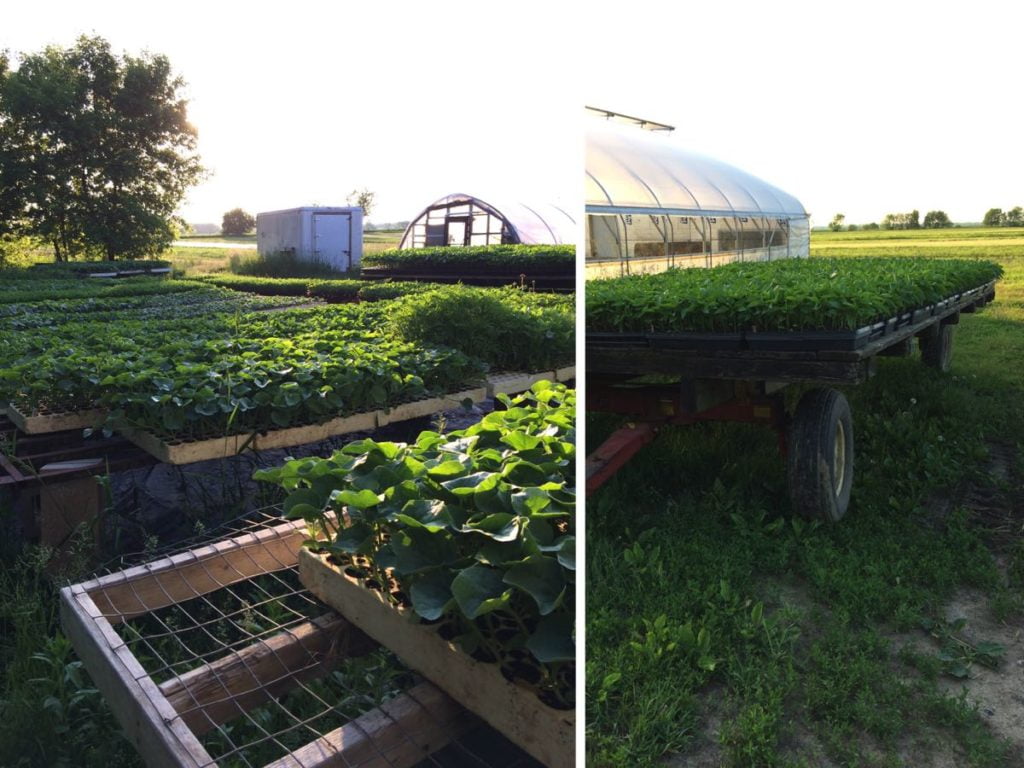
There’s a traffic jam at the greenhouses. All the outdoor benches (plus two wagons) are filled with plants ready to go in the ground.
The wet weather has slowed us down, and stopped all field operations except harvest. Our field tillage is stalled. We mowed down our rye cover crops but it’s too wet to work the residue into the soil. Steve is getting very impatient. We have many transplants ready to go in the ground. By this week last year, we had already transplanted all of our summer crops. Last spring was fast-moving with many warm days. Not this year. Unfortunately, there’s nothing we can do, except gather a crew to work on Saturday before it rains again on Sunday. We really need a break from the rain.
How to wash greens efficiently
Everything needs careful washing this week. All the rain splashed grit into the lettuce, escarole, etc. Here’s our approach. It works.
1. We have one kitchen sink so we use a 4 gallon Rubbermaid basin. Fill halfway with cold tap water. If you have two sinks, fill one sink partway with cold water.
2. Chop your lettuce, spinach, escarole or other green to the size you wish.
3. Dump it into the water and swish around gently but thoroughly.
4. Working in two batches (for average lettuce head) or more batches (big spinach bunches, Romaine), pull handfuls out of the water and drain in the basket of a salad spinner.
5. After all the greens have been rinsed one time, dump the water. Rinse the basin and refill with cold tap water.
6. Repeat the process.
7. Spin your greens dry and store in a dry container. They store much better when spun dry.
This works because …
– pre-chopping the greens frees soil trapped in the head.
– the large amount of water washes and dilutes away the grit.
– By pulling the greens out of the water, you take advantage of the draining action to pull the grit with it.
If you don’t have a salad spinner, try crew leader Kerry’s approach to dry her washed greens. She puts them in a colander, wraps the colander in a towel, and spins it around her head. This is a good job for outdoors. I hope this helps!
Veggie List and Veggie Notes
Week #3, June 6/7, 2019
– weekly shares
– every-other-week/ purple
– sampler/ sun
Asparagus, 2/3 lb
Shiitake mushrooms, 8 oz
Spinach, 1 bunch
Escarole, 1 large or 2 small
Romaine lettuce, 1 large or 2 small
White salad turnips, 1 bunch
Scallions, 1 bunch
Next week’s box will probably contain asparagus, greens, lettuce, white salad turnips, radishes, scallions & more.
Asparagus – Some of this week’s harvest is from our farm. Some is from our friends at LOTFOTL. All is certified organic.
Shiitake mushrooms – These are from Hidden Valley Mushrooms, the same people who grew last week’s button mushrooms. I love shiitakes cooked with spinach or other greens. Shiitakes must be cooked. A small subset of people can have a toxic reaction to raw or undercooked shiitakes. Once cooked, they are harmless. And tasty!
Storage: Refrigerate in a paper bag. These are perishable so use soon. Lightly sauce in butter and add to any dish. I will use mine in a frittata, as well as sauteed and mixed into pasta salad. Sauteed shiitakes and spinach are a great topping for rice bowls, e.g. bibimbap.
Escarole (broad head of wavy green leaves) – This member of the chicory family can be eaten raw or cooked. Its slightly bitter flavor is a good addition to mixed salads. It is excellent cooked alone or mixed with other greens. It cooks quickly, but not as quickly as spinach. Cover and refrigerate.
Romaine lettuce (upright head of lettuce with crisp leaves) – More sturdy and less fragile than our other spring lettuces. Great for Caesar Salad or lettuce wraps. Many heads have rusty spots at the base. However, what you see on the outside is the worst of it. Cut away the base just above those spots and you’ll eliminate the ones inside too.
White salad turnips (bunched white roots with green tops) – I know that returning members look forward to these sweet and delicious turnips, which taste nothing like the turnips that are harvested in fall. Don’t be fooled by how big the turnips are. These might be the best turnips we’ve ever grown.
– Storage: Cover and refrigerate.
– Uses: Both the turnip roots and tops are edible. The roots are excellent raw; Slice and add to salads. They can be cooked and are especially good when lightly sauteed in butter. Stir as little as possible so they brown on at least one side. The turnips greens are excellent cooked. Treat them like mustard greens.
– Our favorite use: Slice the roots very thinly and combine with a mixture of rice vinegar, mirin, soy sauce, sesame oil. Eat immediately or marinate.
Scallions (bundle of green onions) – These are useful raw or cooked. Thinly-sliced raw scallions can be folded into biscuit dough or sprinkled on top of soups or salads. Terrific garnish for pasta dishes. Think pad thai.
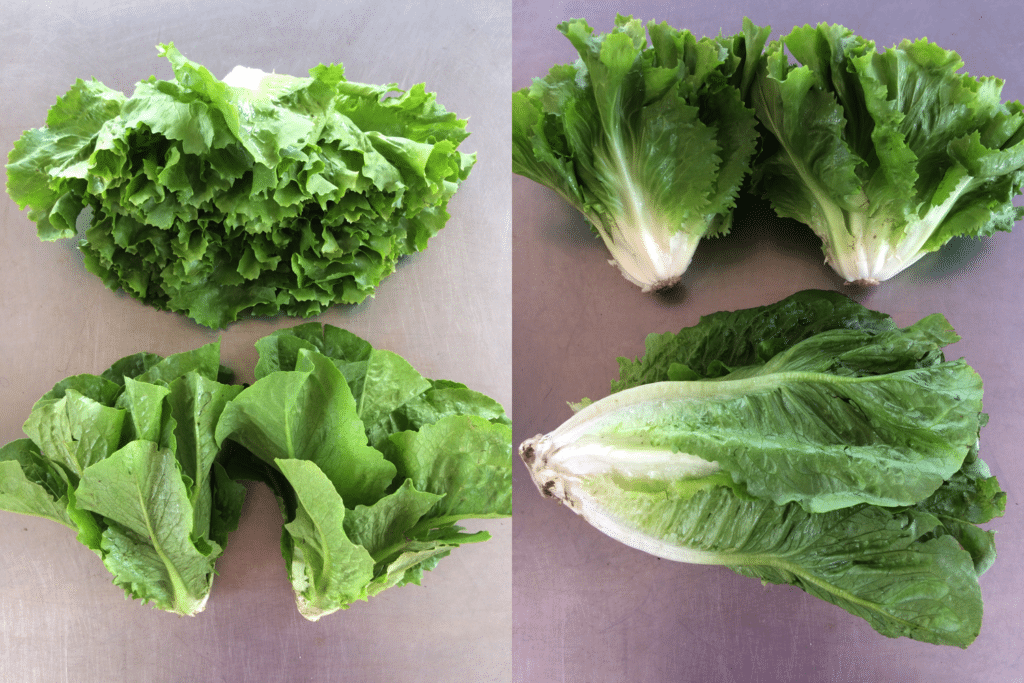
Escarole and Romaine lettuce look superficially similar. Escarole (top in both photos) has a broader fan shape and more bitter leaves. Romaine (bottom in both photos) is more upright and tastes like … Romaine. Most people get …
1 large escarole + 2 small Romaine OR
2 small escarole + 1 large Romaine.
RECIPES
Visit our 2019 Recipe Log or our 2018 Recipe Log or join our Facebook discussion group.
LOCAL THYME/ Comforting Classics
Cobb-ish Salad
Warm Escarole Salad
Scallion Pancake
Two Green, Salad Turnip and Feta Scramble
LOCAL THYME/ Outside the Box Recipes
Roasted Stuffed Romaine
Pan-Fried White Beans and Escarole
Grilled Salad Turnips and Asparagus with Scallions and Chili Garlic Sauce
Turnip Greens and Fish Tacos with Quick Pickled Salad Turnips
LOCAL THYME/ Quick & Easy Recipe
Spinach and Asparagus Pasta Salad with Feta
RECIPES FROM LAUREN
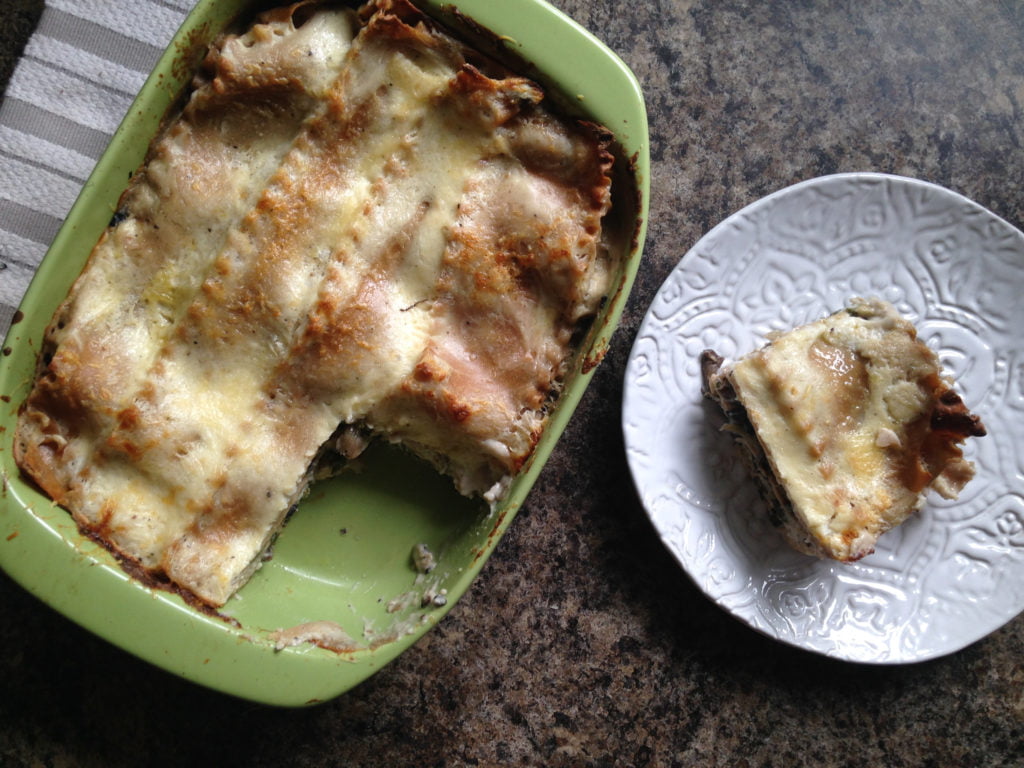
Photo credit Lauren Rudersdorf
SHIITAKE, ESCAROLE & SPINACH LASAGNA WITH WHITE SAUCE
Inspired by the great Ina Garten
Takes 1 hour, 30 minutes
Serves 6-8 depending on your appetite
10 tablespoons butter, divided
1/2 cup flour
4 cups warm whole milk (whole is preferred, but 2% will also work fine), I throw mine in the microwave for 60 seconds to warm it
1 tablespoon Kosher salt, divided
1/2 teaspoon freshly ground black pepper
1 pound dried lasagna noodles
3 garlic cloves, minced
3 scallions, white and pale green parts only, thinly sliced
8 ounces shittake mushrooms, cleaned and sliced
1 head escarole, roughly chopped (about 6 cups)*
1 head spinach (or turnip greens), roughly chopped (about 3 cups)*
1-1/2 cups freshly shredded Parmesan
- Preheat the oven to 375 degrees.
- Bring a large pot of salted water to a boil.
- While waiting for the water to boil, begin your white sauce. Melt 8 tablespoons of butter in a large saucepan over medium low heat. Once fully melted, add the flour and stir constantly with a whisk for 1 minute. Pour in the warm milk, 1 tablespoon Kosher salt, 1 teaspoon black pepper and whisk consistently for 15 minutes, scraping the bottom and edges of the pan occasionally, or until mixture is thickened. Remove from heat.
- By now, your water is likely boiling. Add the lasagna noodles and cook for 10 minutes or until al dente. Strain, toss with olive oil in colander and set aside.
- Meanwhile, melt remaining butter in a large saute pan (or even Dutch oven– you need a big pot to fit all these greens!) over medium heat. Add garlic and scallions. Saute for 3-5 minutes until fragrant. Add mushrooms and sprinkle with salt and pepper. Cook for about 3 minutes until just beginning to release their juices. Add the escarole and spinach and cook until greens are wilted, about 5 minutes longer. There will likely be a lot of liquid in the pan. That’s fine.
- In a 9×13-inch pan, begin to layer the lasagna. First spread about a 1/2 cup of white sauce on the bottom of the pan, just enough to cover it followed by three noodles, overlapped slightly. Add 1/4†of the remaining sauce followed by 1/3 of the mushroom mixture, and 1/4 cup of Parmesan. Continue this layering two more times: noodles, sauce, mushroom mixture and Parmesan. Finishing with a fourth layer of noodles, the remaining sauce and cheese.
- Bake the lasagna for 45 minutes, until the top is browned and bubbly. Let set for 15 minutes before diving in. Serve with a simple green salad.
.
*Much like the “Lots o’ Greens” quiche, this recipe really just needs 9 cups of any greens. I used escarole and spinach in my testing, but turnip greens, kale, radish greens, or anything else you have lying around (or want to use up first) would also work great!
.????
.????
BRIGHT SPRING SALAD WITH TURNIPS & APPLE
1 head lettuce, leaves washed, dried and separated, roughly chopped into bite-sized pieces
5 turnips, cut into match-sticks
1 sweet-tart apple (such as Pink Lady), cut into match-sticks
3 scallions, trimmed, thinly sliced
1/4 cup fresh lemon juice
1/2 cup olive oil
1 teaspoon finely grated peeled ginger
1 teaspoon poppy seeds
1/2 teaspoon Kosher salt
1/4 teaspoon freshly ground black pepper
1/2 cup chopped toasted walnuts
1/4 cup finely shredded Parmesan, optional
- Divide lettuce into four small bowls. Top with turnips, apples and scallions.
- In a large bowl, combine lemon juice, olive oil, ginger, poppy seeds, salt and pepper. Taste and adjust seasonings as desired.
- Drizzle a couple tablespoons of the dressing over each salad. Toss gently and add more to taste. Top with walnuts as well as shredded Parmesan if using.
.



